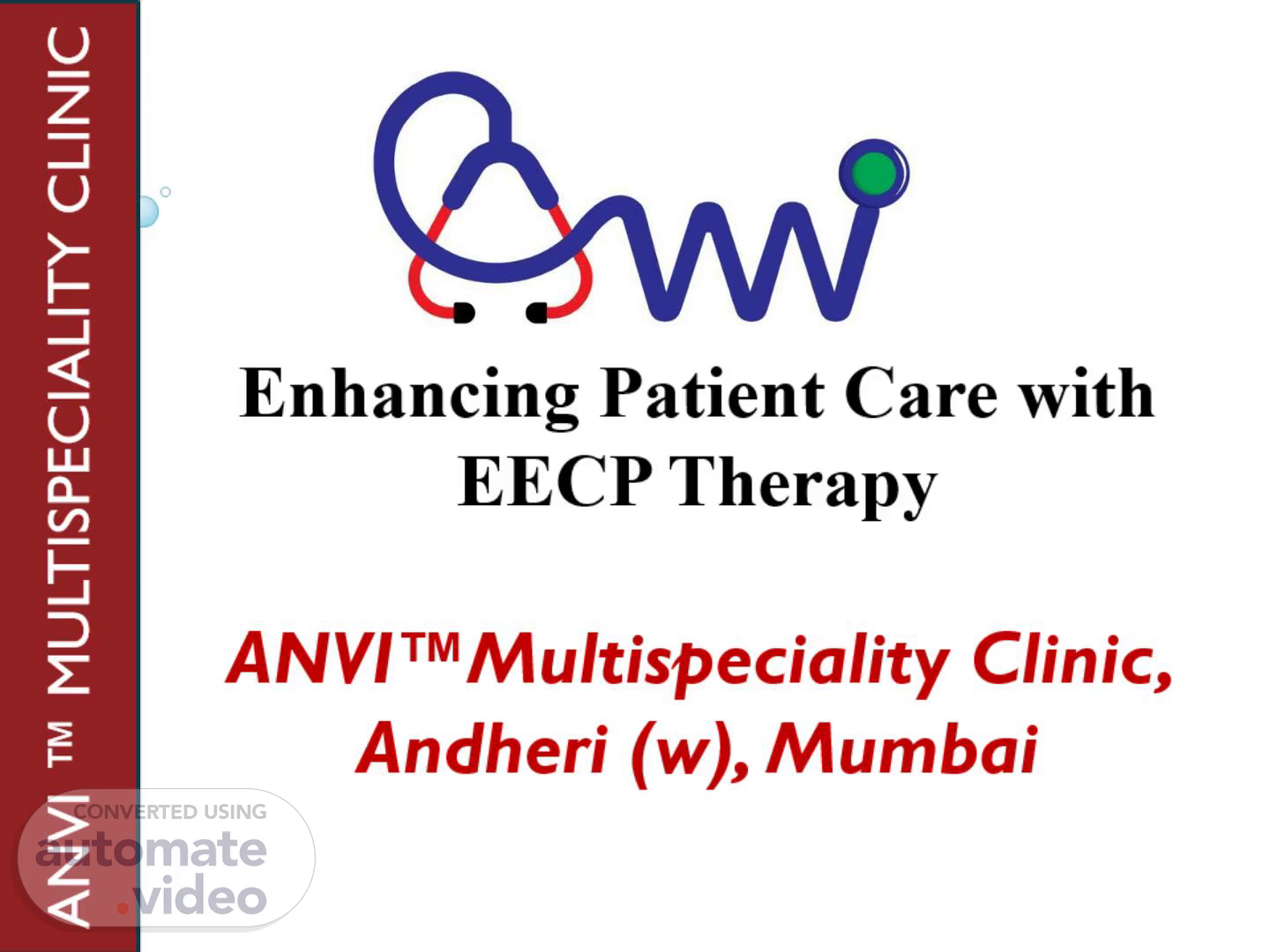
PowerPoint Presentation
Scene 1 (0s)
[Audio] ANVI ™ MULTISPECIALITY CLINIC Enhancing Patient Care with EECP Therapy ANVI™Multispeciality Clinic, Andheri (w), Mumbai www.anvimultispecialityclinic.com.
Scene 2 (17s)
[Audio] INTRODUCTION Welcome to ANVI™ Multispeciality Clinic's introduction to Enhanced External Counter Pulsation (EECP) Therapy. This presentation aims to provide essential information to facilitate informed decision-making when considering EECP therapy..
Scene 3 (36s)
[Audio] What is EECP Therapy? EECP therapy, also known as Enhanced External Counter Pulsation, is a non-invasive outpatient treatment for cardiovascular conditions such as Angina, Heart Failure, and Coronary Artery Disease. It is popularly referred to as the "Natural Bypass Treatment For Heart.“ EECP can be considered as a “Second Heart” or “a Heart to a Heart”..
Scene 4 (1m 5s)
[Audio] Is EECP Therapy Invasive? No, EECP therapy is entirely a non-invasive treatment, making it a safe option for patients who are not suitable candidates for invasive procedures..
Scene 5 (1m 18s)
[Audio] Procedure Overview During an EECP session, patients lie on a specialised treatment bed wrapped in pneumatic cuffs around their calves, lower and upper thighs, and buttocks. The cuffs inflate and deflate sequentially to create a high pressure counter-pulse which is in sync with the diastolic phase of each cardiac cycle under an Electrocardiographic (ECG) trigger..
Scene 6 (1m 43s)
[Audio] Mechanism of Action EECP Therapy enhances the formation of collateral circulation and hence blood supply to the salvageable heart muscles compromised by the blocked blood vessels (coronaries). By generating the “Counter-pulsation”, EECP treatment leads to increased blood flow to the coronaries (vessels supplying blood to heart muscles) and hence coronary perfusion. The systolic unloading of the left ventricle may gradually increase the ventricular output (ejection fraction)..
Scene 7 (2m 19s)
[Audio] EECP treatment increases the release of NO and PGE2 by causing shear stress on the inner lining of blood vessels causing dilatation of coronaries and hence blood flow to heart muscles. The simultaneous release of factors like VEGF increase angiogenesis (blood vessels formation) and hence aid in formation of collaterals and increase coronary microcirculation..
Scene 8 (2m 50s)
[Audio] Mechanism of Action (Contd..) With daily sessions of the EECP, gradually the collateral circulation of the coronaries start forming and opening. This leads to improved blood flow to the Heart muscles, Reducing Myocardial Oxygen Demand and enhance cardiac function. EECP has also been shown to have anti-inflammatory effects in patients with symptomatic angina..
Scene 9 (3m 16s)
[Audio] What does “Counter Pulsation” mean? With the sequential inflation of the pneumatic cuffs from below upwards under high pressure a pressure waveform during the counter (or reverse) phase of normal cardiac pulsation in diastole (Heart Ventricular relaxation phase) is generated. This is known as “Counterpulsation”..
Scene 10 (3m 41s)
[Audio] How does “Counter Pulsation” increase Coronary Blood Flow? The Counter Pulsation leads to an augmentation (increase) of aortic pressure during diastole (relaxation phase of cardiac cycle) against the closed aortic valve. This enhances blood flow to the coronaries (vessels supplying blood to heart muscles) and hence coronary perfusion..
Scene 11 (4m 7s)
[Audio] What does “Systolic Unloading” mean? After the sequential high pressure inflation of the pneumatic cuffs, all the cuffs are deflated suddenly during the systole (Electrocardiographic triggered deflation). This causes suction like effect, which reduces the afterload and is called “Systolic Unloading” of the Left Ventricle of Heart..
Scene 12 (4m 29s)
[Audio] Who can take EECP Treatment? Ideal candidates for EECP therapy include patients with: Coronary Artery Disease. Refractory angina. Awaiting invasive interventions such as coronary angioplasty or bypass surgery. Co-morbid conditions making then unfit for invasive interventions such as coronary angioplasty or bypass surgery. History of having undergone coronary angioplasty/Bypass surgery but still having symptoms. Ischemic or Idiopathic Cardiomyopathy. Stable Heart Failure (NYHA Class II & III) Left Ventricular Dysfunction (EF < 35%) Cardiac Syndrome X (Microvascular Angina).
Scene 13 (5m 14s)
[Audio] Treatment Benefits EECP therapy has potential to improve Symptoms, Exercise Capacity, Walking Distance and Quality of life in patients with cardiovascular conditions. After completing the treatment course, patients experience improvements in objective measures such as the 6-minute walk test, Echocardiographic parameters, and subjective symptoms and wellbeing. It may also have positive effects on other vital organs and overall well-being..
Scene 14 (5m 41s)
[Audio] Treatment Protocol EECP therapy consists of 35-40 sessions, each lasting 45-60 minutes. Patients are monitored throughout the sessions, and parameters such as Blood Pressure, Oxygen Saturation, and ECG are closely monitored. At ANVI™ Multispeciality Clinic, EECP Treatment is given after complete assessment and in full supervision of Dr. Asmita D. Chaturvedi, M.B.B.S.; M.D.(Medicine).
Scene 15 (6m 15s)
[Audio] Clinical Evidence Multiple randomised controlled trials and meta-analyses have demonstrated the efficacy of EECP therapy in improving angina symptoms, exercise capacity, and quality of life in patients with refractory angina and heart failure..
Scene 16 (7m 10s)
[Audio] . Clinical Evidence. [image] Enhanced external counterpulsation improves systolic blood pressure in patients with refractory angina R. • • G. Kayla M. C • L RN "A. • Anil K- R. RS, • Kim A. Mm b Ti—hy D. MD' MN.